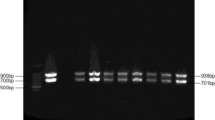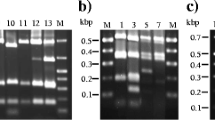Abstract
Bacteria inside biofilms are more persistent and resistant to stress conditions found in the production environment of food processing plants, thus representing a constant risk for product safety and quality. Therefore, the aim of this study was to characterize, using 16S rRNA sequencing, the bacterial communities from biofilms found in four food processing plants (P1, P2, P3, and P4). In total, 50 samples from these four processing plants were taken after cleaning and disinfection processes. Four phyla: Proteobacteria, Firmicutes, Actinobacteria, and Bacteroides represented over 94% of the operational taxonomic units found across these four plants. A total of 102 families and 189 genera were identified. Two genera, Pseudomonas spp. and Acinetobacter spp., were the most frequently found (93.47%) across the four plants. In P1, Pseudomonas spp. and Lactobacillus spp. were the dominant genera, whereas Lactobacillus spp. and Streptococcus spp. were identified in P2. On the other hand, biofilms found in P3 and P4 mainly consisted of Pseudomonas spp. and Acinetobacter spp. Our results indicate that different bacterial genera of interest to the food industry due to their ability to form biofilm and affect food quality can coexist inside biofilms, and as such, persist in production environments, representing a constant risk for manufactured foods. In addition, the core microbiota identified across processing plants evaluated was probably influenced by type of food produced and cleaning and disinfection processes performed in each one of these.



Similar content being viewed by others
References
Norman MM, Schilling W, Gravani RB (2018) Principles of food sanitation [Internet], 6th edn. Springer, Berlin 422 p. Disponível em: https://www.springer.com/la/book/9783319671642#aboutBook
Esbelin J, Santos T, Hébraud M (2018) Desiccation: an environmental and food industry stress that bacteria commonly face. Food Microbiol 69:82–88
Ostrov I, Sela N, Belausov E, Steinberg D, Shemesh M (2019) Adaptation of Bacillus species to dairy associated environment facilitates their biofilm forming ability. Food Microbiol 82:316–324
Ferreira V, Wiedmann M, Teixeira P, Stasiewicz MJ (2014) Listeria monocytogenes persistence in food-associated environments: epidemiology, strain characteristics, and implications for public health. J Food Prot 77(1):150–170
Møretrø T, Langsrud S, Heir E (2013) Bacteria on meat abattoir process surfaces after sanitation: characterisation of survival properties of Listeria monocytogenes and the commensal bacterial flora. Adv Microbiol 03(03):255–264
Bridier A, Briandet R, Thomas V, Dubois-Brissonnet F (2011) Resistance of bacterial biofilms to disinfectants: a review. Biofouling 27(9):1017–1032
Saucier L (2016) Microbial spoilage, quality and safety within the context of meat sustainability. Meat Sci 120:78–84
de Souza EL, Meira QGS, de Medeiros BI, Athayde AJAA, da Conceição ML, de Siqueira Júnior JP (2014) Biofilm formation by Staphylococcus aureus from food contact surfaces in a meat-based broth and sensitivity to sanitizers. Braz J Microbiol 45(1):67–75
Langsrud S, Moen B, Møretrø T, Løype M, Heir E (2016) Microbial dynamics in mixed culture biofilms of bacteria surviving sanitation of conveyor belts in salmon-processing plants. J Appl Microbiol 120(2):366–378
Schirmer BCT, Heir E, Møretrø T, Skaar I, Langsrud S (2013) Microbial background flora in small-scale cheese production facilities does not inhibit growth and surface attachment of Listeria monocytogenes. J Dairy Sci 96(10):6161–6171
Gutiérrez D, Delgado S, Vázquez-Sánchez D, Martínez B, Cabo ML, Rodríguez A et al (2012) Incidence of Staphylococcus aureus and analysis of associated bacterial communities on food industry surfaces. Appl Environ Microbiol 78(24):8547–8554
Brightwell G, Boerema J, Mills J, Mowat E, Pulford D (2006) Identifying the bacterial community on the surface of Intralox belting in a meat boning room by culture-dependent and culture-independent 16S rDNA sequence analysis. Int J Food Microbiol 109(1–2):47–53
Giaouris E, Heir E, Hébraud M, Chorianopoulos N, Langsrud S, Møretrø T et al (2014) Attachment and biofilm formation by foodborne bacteria in meat processing environments: causes, implications, role of bacterial interactions and control by alternative novel methods. Meat Sci 97(3):298–309
Winkelströter LK, Teixeira FB d R, Silva EP, Alves VF, De Martinis ECP (2014) Unraveling microbial biofilms of importance for food microbiology. Microb Ecol 68(1):35–46
Liu NT, Nou X, Bauchan GR, Murphy C, Lefcourt AM, Shelton DR et al (2015) Effects of environmental parameters on the dual-species biofilms formed by Escherichia coli O157:H7 and Ralstonia insidiosa, a strong biofilm producer isolated from a fresh-cut produce processing plant. J Food Prot 78(1):121–127
Tarifa MC, Lozano JE, Brugnoni LI (2015) Dual-species relations between Candida tropicalis isolated from apple juice ultrafiltration membranes, with Escherichia coli O157:H7 and Salmonella sp. J Appl Microbiol 118(2):431–442
Burmølle M, Ren D, Bjarnsholt T, Sørensen SJ (2014) Interactions in multispecies biofilms: do they actually matter? Trends Microbiol 22(2):84–91
Giaouris E, Chorianopoulos N, Doulgeraki A, Nychas G-J (2013) Co-culture with Listeria monocytogenes within a dual-species biofilm community strongly increases resistance of Pseudomonas putida to benzalkonium chloride. PLoS One 8(10):e77276
Olivier H, Heir E, Langsrud S, Åsli AW, Møretrø T (2010) Enhanced surface colonization by Escherichia coli O157:H7 in biofilms formed by an Acinetobacter calcoaceticus isolate from meat-processing environments. Appl Environ Microbiol 76(13):4
Mertz AW, Koo OK, O’Bryan CA, Morawicki R, Sirsat SA, Neal JA et al (2014) Microbial ecology of meat slicers as determined by denaturing gradient gel electrophoresis. Food Control 42:242–247
Rinke C, Schwientek P, Sczyrba A, Ivanova NN, Anderson IJ, Cheng J-F et al (2013) Insights into the phylogeny and coding potential of microbial dark matter. Nature 499(7459):431–437
Fagerlund A, Møretrø T, Heir E, Briandet R, Langsrud S (2017) Cleaning and disinfection of biofilms composed of Listeria monocytogenes and background microbiota from meat processing surfaces. Appl Environ Microbiol
Verran J, Redfern J, Smith LA, Whitehead KA (2010) A critical evaluation of sampling methods used for assessing microorganisms on surfaces. Food Bioprod Process 88(4):335–340
Chmielewski RAN, Frank JF (2003) Biofilm formation and control in food processing facilities. Compr Rev Food Sci Food Saf 2(1):22–32
Yang B, Wang Y, Qian P-Y (2016) Sensitivity and correlation of hypervariable regions in 16S rRNA genes in phylogenetic analysis. BMC Bioinformatics [Internet]. [citado 17 de fevereiro de 2018];17(1). Disponível em: http://www.biomedcentral.com/1471-2105/17/135
Edgar RC (2010) Search and clustering orders of magnitude faster than BLAST. Bioinforma Oxf Engl 26(19):2460–2461
Edgar RC, Haas BJ, Clemente JC, Quince C, Knight R (2011) UCHIME improves sensitivity and speed of chimera detection. Bioinformatics 27(16):2194–2200
Edgar RC (2013) UPARSE: highly accurate OTU sequences from microbial amplicon reads. Nat Methods 10(10):996–998
Ramette A (2007) Multivariate analyses in microbial ecology. FEMS Microbiol Ecol 62(2):142–160
Culligan EP, Sleator RD, Marchesi JR, Hill C (2014) Metagenomics and novel gene discovery: promise and potential for novel therapeutics. Virulence 5(3):399–412
Ismaïl R, Aviat F, Michel V, Le Bayon I, Gay-Perret P, Kutnik M et al (2013) Methods for recovering microorganisms from solid surfaces used in the food industry: a review of the literature. Int J Environ Res Public Health 10(11):6169–6183
Janda JM, Abbott SA (2014) Culture-independent diagnostic testing: have we opened Pandora’s box for good? Diagn Microbiol Infect Dis 80(3):171–176
Møretrø T, Langsrud S (2017) Residential bacteria on surfaces in the food industry and their implications for food safety and quality: residential bacteria in food industry. Compr Rev Food Sci Food Saf 16(5):1022–1041
Flores GE, Bates ST, Caporaso JG, Lauber CL, Leff JW, Knight R et al (2013) Diversity, distribution and sources of bacteria in residential kitchens: bacterial diversity of residential kitchens. Environ Microbiol 15(2):588–596
Jagadeesan B, Gerner-Smidt P, Allard MW, Leuillet S, Winkler A, Xiao Y et al (2019) The use of next generation sequencing for improving food safety: translation into practice. Food Microbiol 79:96–115
Kembel SW, Meadow JF, O’Connor TK, Mhuireach G, Northcutt D, Kline J et al (2014) Architectural design drives the biogeography of indoor bacterial communities. White BA, organizador. PLoS One 9(1):e87093
Zhang Y, Wei J, Yuan Y, Yue T (2019) Diversity and characterization of spoilage-associated psychrotrophs in food in cold chain. Int J Food Microbiol 290:86–95
Gadea R, Fernández Fuentes MÁ, Pérez Pulido R, Gálvez A, Ortega E (2017) Effects of exposure to quaternary-ammonium-based biocides on antimicrobial susceptibility and tolerance to physical stresses in bacteria from organic foods. Food Microbiol 63:58–71
Abdallah M, Khelissa O, Ibrahim A, Benoliel C, Heliot L, Dhulster P et al (2015) Impact of growth temperature and surface type on the resistance of Pseudomonas aeruginosa and Staphylococcus aureus biofilms to disinfectants. Int J Food Microbiol 214:38–47
Puga CH, Orgaz B, SanJose C (2016) Listeria monocytogenes impact on mature or old Pseudomonas fluorescens biofilms during growth at 4 and 20°C. Front Microbiol 7:134
Lapointe C, Deschênes L, Ells TC, Bisaillon Y, Savard T (2019) Interactions between spoilage bacteria in tri-species biofilms developed under simulated meat processing conditions. Food Microbiol 82:515–522
Stellato G, La Storia A, Cirillo T, Ercolini D (2015) Bacterial biogeographical patterns in a cooking center for hospital foodservice. Int J Food Microbiol 193:99–108
Carvalheira A, Casquete R, Silva J, Teixeira P (2017) Prevalence and antimicrobial susceptibility of Acinetobacter spp. isolated from meat. Int J Food Microbiol 243:58–63
Hansen SK, Haagensen JAJ, Gjermansen M, Jørgensen TM, Tolker-Nielsen T, Molin S (2007) Characterization of a Pseudomonas putida rough variant evolved in a mixed-species biofilm with Acinetobacter sp. strain C6. J Bacteriol 189(13):4932–4943
Li J, Yang X, Shi G, Chang J, Liu Z, Zeng M (2019) Cooperation of lactic acid bacteria regulated by the AI-2/LuxS system involve in the biopreservation of refrigerated shrimp. Food Res Int 120:679–687
Hultman J, Rahkila R, Ali J, Rousu J, Björkroth KJ (2015) Meat processing plant microbiome and contamination patterns of cold-tolerant bacteria causing food safety and spoilage risks in the manufacture of vacuum-packaged cooked sausages. Drake HL, organizador. Appl Environ Microbiol 81(20):7088–7097
Perpetuini G, Pham-Hoang BN, Scornec H, Tofalo R, Schirone M, Suzzi G et al (2016) In Lactobacillus pentosus, the olive brine adaptation genes are required for biofilm formation. Int J Food Microbiol 216:104–109
Gounadaki AS, Skandamis PN, Drosinos EH, Nychas G-JE (2008) Microbial ecology of food contact surfaces and products of small-scale facilities producing traditional sausages. Food Microbiol 25(2):313–323
Montgomery NL, Banerjee P (2015) Inactivation of Escherichia coli O157:H7 and Listeria monocytogenes in biofilms by pulsed ultraviolet light. BMC Res Notes [Internet]. [citado 28 de agosto de 2019];8(1). Disponível em: http://www.biomedcentral.com/1756-0500/8/235
Tadepalli S, Bridges DF, Driver R, Wu VCH (2018) Effectiveness of different antimicrobial washes combined with freezing against Escherichia coli O157:H7, Salmonella Typhimurium, and Listeria monocytogenes inoculated on blueberries. Food Microbiol 74:34–39
Holah JT, Bird J, Hall KE (2004) The microbial ecology of high-risk, chilled food factories; evidence for persistent Listeria spp. and Escherichia coli strains. J Appl Microbiol 97(1):68–77
Cleto S, Matos S, Kluskens L, Vieira MJ (2012) Characterization of contaminants from a sanitized milk processing plant. PLoS One 7(6):e40189
Langsrud S, Møretrø T, Sundheim G (2003) Characterization of Serratia marcescens surviving in disinfecting footbaths. J Appl Microbiol 95(1):186–195
Marchand S, De Block J, De Jonghe V, Coorevits A, Heyndrickx M, Herman L (2012) Biofilm formation in milk production and processing environments; Influence on Milk Quality and Safety. Compr Rev Food Sci Food Saf 11(2):133–147
Stellato G, De Filippis F, La Storia A, Ercolini D (2015) Coexistence of lactic acid bacteria and potential spoilage microbiota in a dairy processing environment. Elkins CA, organizador. Appl Environ Microbiol 81(22):7893–7904
De Filippis F, La Storia A, Villani F, Ercolini D (2013) Exploring the sources of bacterial spoilers in beefsteaks by culture-independent high-throughput sequencing. Virolle M-J, organizador. PLoS One 8(7):e70222
Funding
This study was supported by COLCIENCIAS grant 55965, the Research and Development, Zenu Food Industry Medellín, and the Colombia Research group Colombian Institute of Tropical Medicine and CES University.
Author information
Authors and Affiliations
Corresponding author
Additional information
Responsible Editor: Luis Augusto Nero.
Publisher’s note
Springer Nature remains neutral with regard to jurisdictional claims in published maps and institutional affiliations.
Rights and permissions
About this article
Cite this article
Caraballo Guzmán, A., González Hurtado, M.I., Cuesta-Astroz, Y. et al. Metagenomic characterization of bacterial biofilm in four food processing plants in Colombia. Braz J Microbiol 51, 1259–1267 (2020). https://doi.org/10.1007/s42770-020-00260-x
Received:
Accepted:
Published:
Issue Date:
DOI: https://doi.org/10.1007/s42770-020-00260-x




